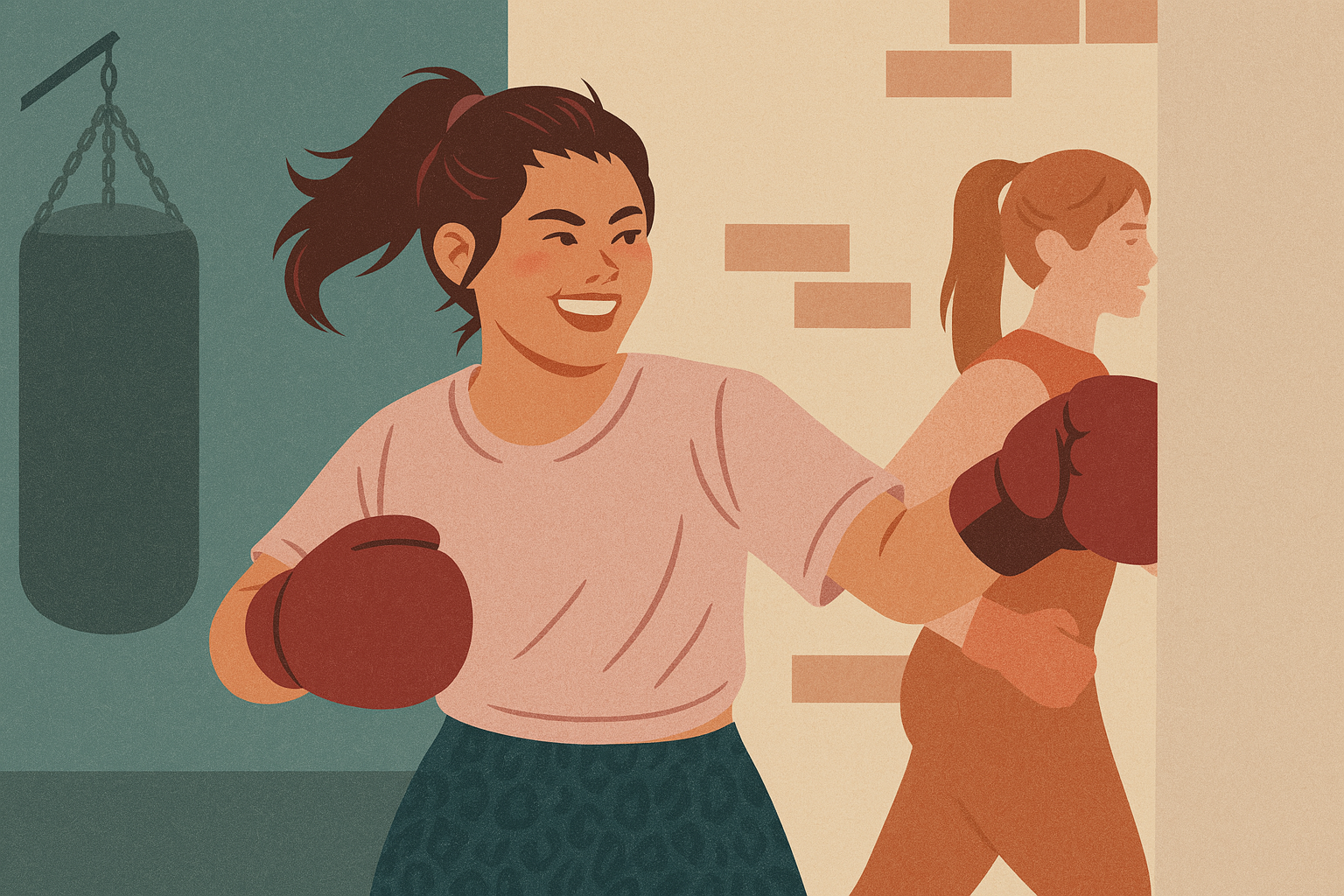Die vier Jahreszeiten
Die vier Jahreszeiten Menstruierende Personen durchlaufen eine Art hormonellen Tanz, der ihr Wohlbefinden beeinflusst und den vier Jahreszeiten ähnelt. Der Winter markiert die Menstruation, im Frühling reift das Ei heran, im Sommer erfolgt die Ovulation und im Herbst wird die Gebärmutterschleimhaut abgestoßen, wobei oft PMS-Symptome auftreten. Viele Frauen leiden ihr Leben lang unter körperlichen und psychischen Menstruationsproblemen, aber durch die Beachtung bestimmter Tipps kannst du während deines Zyklus aufblühen.

Frauen sind keine kleinen Männer - die Kraft des hormonellen Zyklus nutzen
Was sind eigentlich Hormone? Hormone sind die chemischen Botenstoffe der Kontrollzentren im Gehirn und Körper. Sie steuern alles, was unsere Körperfunktionen reguliert, von unserer Fähigkeit, mit Stress umzugehen, über unsere Schlafzyklen, bis hin zu unserer Energie und oft auch zu den lästigen Süßigkeiten-Gelüsten, die wir erleben. Hormone werden direkt in den Blutkreislauf ausgeschüttet, wo sie ihre Wirkung entfalten, indem sie an spezifische Rezeptoren binden. Sie halten das Gleichgewicht und die Homöostase im Körper aufrecht.

Tageszyklus und hormoneller Zyklus
Wir alle wissen, dass ein Tag 24 Stunden hat. Normalerweise wachen wir morgens mit einem Anstieg des Cortisols auf, das im Laufe des Tages abnimmt. Abends setzt Melatonin ein und signalisiert unserem Körper, dass es Zeit ist, sich auszuruhen. Frauen haben auch einen zusätzlichen Rhythmus, unseren monatlichen Zyklus. Dieser Zyklus wird von unseren Hormonen, insbesondere Östrogen und Progesteron, gesteuert. Unser monatlicher Zyklus hat genauso viel Einfluss auf unseren Körper wie der Tageszyklus, und genauso wie man seinen Tag und Schlaf mit bestimmten Protokollen optimieren kann, kann man auch seinen monatlichen Zyklus optimieren, um sich am besten zu fühlen. Ein Menstruationszyklus beginnt mit dem ersten Tag der Menstruation und endet mit dem Beginn der nächsten Menstruation. Zyklen variieren und ein normaler Zyklus kann zwischen 24 und 38 Tagen liegen, aber die Länge kann von Zyklus zu Zyklus variieren und sich im Laufe der Jahre ändern, beispielsweise in Zeiten von Stress oder während des Übergangs zur Perimenopause.
Zyklusphasen
Wenn wir unseren monatlichen Zyklus betrachten, können wir ihn in 4 Phasen unterteilen - wie die 4 Jahreszeiten.

Menstruationsphase - Winter
Wir beginnen im Winter: Genau wie das Jahr für uns beginnt, beginnt auch der weibliche Zyklus neu. Du bekommst deine Periode. Deshalb wird diese Phase Menstruationsphase genannt. Während dieser Phase sind Östrogen und Progesteron, unsere Sexualhormone, auf einem Minimum. Während dieser Phase bricht die Gebärmutterschleimhaut, die sich im Laufe des Monats zur Vorbereitung auf eine mögliche Schwangerschaft aufgebaut hat, zusammen und diese Gewebe werden durch die Vagina entfernt. In dieser Zeit wird uns kalt - buchstäblich - mit einem Rückgang der Körpertemperatur um ein halbes Grad. Diese Phase ist eine energieintensive Zeit, in der du möglicherweise Heißhunger, Krämpfe verspürst und zu Hause bleiben und dich unter die Decke kuscheln möchtest. Genau wie zum Jahreswechsel ist dies der perfekte Moment für Reflexion und Veränderung.
Empfehlungen:
- Dein Körper regeneriert sich. Folge deinem Wunsch nach Ruhe und Entspannung und nimm es leicht.
- Dies ist die Zeit, um den vergangenen Monat zu bewerten und zu reflektieren, deinen Monatsplaner zu überprüfen und Muster zu erkennen, dich zu fragen, ob dir die Projekte gefallen, an denen du arbeitest, oder ob deine Karriere in die richtige Richtung geht.
- Höre auf dein Bauchgefühl. Priorisiere wärmende, nährstoffreiche Lebensmittel. Iss mageres Eiweiß und pflanzliche Optionen wie Bohnen, Linsen und Pflaumen, die reich an Eisen sind, um den Eisenverlust während der Blutung auszugleichen, komplexe Kohlenhydrate und gesunde Fette.
- Versuche, Zucker, Alkohol und Koffein zu vermeiden, da diese einige Menstruationssymptome verschlimmern können.
- Gönne dir gelegentlich Leckereien, um deine Gelüste zu stillen. Nimm Magnesium und B-Vitamine, um dich körperlich und emotional zu unterstützen.
.png)
Follikelphase - Frühling
Nach dem kalten Winter erwacht und wächst langsam eine neue Zeit: der Frühling. Dies ist unsere Follikelphase. Die Östrogenspiegel steigen, da ein Follikel in einem der Eierstöcke zum dominanten Follikel wird und derjenige ist, der während der Ovulation freigesetzt wird. In dieser Zeit steigt die Widerstandsfähigkeit und der Wunsch nach Aktivität (buchstäblich und metaphorisch... Frühlingsgefühle). Der Kalorienbedarf ist auf einem Minimum, die Energieniveaus steigen und du bist stressresistent. Der Körper verhält sich in dieser Phase ähnlich wie der eines Mannes. Also, aufdrehen ist erlaubt!
Empfehlungen
- Du hast eine höhere Widerstandsfähigkeit, also kannst du dich im Fitnessstudio mehr pushen. Zu dieser Zeit funktionieren Intervallfasten, HIIT-Workouts und Muskelaufbau gut.
- Dies ist eine großartige Zeit, um neue Projekte zu starten! Denke groß und brainstorme Ideen, gehe herausfordernde mentale Aufgaben an. Dies ist die Zeit, um GROSS zu träumen.
- Integriere mehr Nahrungsquellen, die helfen, Östrogen zu metabolisieren, wie Bohnen, Eier, grasgefüttertes Fleisch, fetten Fisch und fermentierte Lebensmittel wie Kimchi.
- Achte auf deine Eisen- und Vitamin-C-Zufuhr, um deine während der monatlichen Blutung möglicherweise erschöpften Werte wieder aufzufüllen.
Follikel/Ovulationsphase - Sommer
Aus dem Frühling kommt... der Sommer. Dies ist unsere Ovulationsphase. Die Ovulation ist die Freisetzung eines Eies. Der Moment, in dem du schwanger werden kannst. Dies ist in der Mitte des Zyklus. Östrogen, das aktive Hormon, ist auf seinem Maximum. Dies ist die Zeit, in der Frauen die höchste Chance haben, Gene weiterzugeben, und infolgedessen begünstigt die Evolution soziales Verhalten und viel Energie und logischerweise eine hohe Libido. In dieser Zeit setzt die Gebärmutterschleimhaut chemische Substanzen frei oder sezerniert sie, die entweder die Schwangerschaft fördern oder die Membran abbauen und freisetzen, die schließlich während der Menstruation freigesetzt wird, wenn kein Ei befruchtet wurde.
Empfehlungen:
- Gehe tanzen und zu Networking-Events.
- Da du kompromissbereiter bist, ist dies die beste Zeit für schwierige, konfliktbeladene Gespräche.
- Führe wichtige Gespräche, plane Vorstellungsgespräche oder bitte um eine Gehaltserhöhung oder Beförderung bei der Arbeit und verhandle Deals.
- Diese Zeit eignet sich auch perfekt für kreatives Schreiben.
Iss dies:
Achte darauf ausreichend Ballaststoffen zu dir zu nehmen - denke an Pflanzen! Obst, Gemüse, Hülsenfrüchte, Nüsse, Samen und frische Kräuter sind wertvolle Ballaststoffquellen.
Lutealphase - Herbst
Wenn die Spitzenphase, unsere fruchtbare Ovulation, vorbei ist, beginnt der Herbst - die sogenannte Lutealphase. Das Corpus luteum ist der schlaue Name für den Gelbkörper, aus dem dann Progesteron, das Gelbkörperhormon, gebildet wird. Und Progesteron ist der Antagonist zu Östrogen, dämpft und schützt den Körper - denn jetzt geht es darum, die mögliche fragile Schwangerschaft im Körper zu schützen. Die Körpertemperatur steigt, der Grundumsatz erhöht sich um 10% und Energie wird benötigt, um die Gebärmutterschleimhaut aufzubauen - das Zuhause für das Baby. Daher der unstillbare Hunger und das Verlangen nach Schokolade. Um Gewichtszunahme zu vermeiden, ist es sogar wichtig, diesen Hunger zu stillen und zu essen.
Vor dem Winterschlaf erhöhen Tiere ihre Nahrungsaufnahme. Und du solltest dich inspiriert fühlen, dasselbe zu tun. Wähle gesunde, nahrhafte Vollwertkost, um deine Energieniveaus aufrechtzuerhalten. Es ist auch eine gute Idee, den Konsum von Koffein und Alkohol zu reduzieren, da diese PMS-Symptome verschlimmern können. Denn etwas anderes passiert auch: Progesteron macht dich anfälliger für Stress. Und Stress (Cortisol) plus Nahrungsmangel gibt dem Körper das Gefühl von Hungersnot, und dann will er sich mit Fettreserven schützen. Also: mehr essen, mehr schlafen, weniger Action.
Empfehlungen:
Erledige administrative Aufgaben, bearbeite Papierkram und organisiere deinen Schreibtisch und schließe Projekte ab. Dies ist die Zeit, sich tiefgehender Arbeit zu widmen. Überprüfe Dokumente, Verträge und Finanzberichte.
Iss dies:
- Dunkle Schokolade
- Kürbiskerne
- Quinoa
- Schalentiere
- Brokkoli
Viele Frauen haben haben uns widergespiegelt, dass die Umsetzung der hier enthaltenen Strategien dazu beigetragen hat, die negativen Symptome des Menstruationszyklus zu verringern und sich widerstandsfähiger und in der Lage zu fühlen, ihre täglichen Bedürfnisse zu bewältigen.
Quellen
- Rogan, M.M. (2023) Dietary energy intake across the menstrual cycle: a narrative review , Oxford Academic. Available at: https://academic.oup.com/nutritionreviews/article/81/7/869/6823870
- Fathizadeh, N., Ebrahimi, E., Valiani, M., Tavakoli, N., & Yar, M. H. (2010). Evaluating the effect of magnesium and magnesium plus vitamin B6 supplement on the severity of premenstrual syndrome. Iranian journal of nursing and midwifery research, 15(Suppl 1), 401–405.
- Azizah, R.N.P., Anggreini, P. and Prasetya, F. (2022) Effect of combination of dark chocolate and herbal ingredients for dysmenorrhea in late adolescents, Journal of Tropical Pharmacy and Chemistry. Available at: https://doi.org/10.25026/jtpc.v7i1.503
- LOFTUS, D. (2021) Moon cycle cookbook: A holistic nutrition guide for a well-balanced menstrual cycle. S.l.: STOREY BOOKS.
- Begum, M. (2016) ‘Menstrual Disorders: Causes and Natural Remedies’, Journal of Pharmaceutical, Chemical and Biological Sciences [Preprint].
- Fiona C. Baker, Felicia Siboza & Andrea Fuller (2020) Temperature regulation in women: Effects of the menstrual cycle, Temperature, 7:3, 226-262, DOI: 10.1080/23328940.2020.1735927
- Brown, N., Martin, D., Waldron, M., Bruinvels, G., Farrant, L. and Fairchild, R., 2023. Nutritional practices to manage menstrual cycle related symptoms: A systematic review. Nutrition Research Reviews, pp.1-49.
- Kulsum, U. and Astuti, D., 2020, July. The Menstrual Cycle and Nutritional Status. In *1st International Conference on Science, Health, Economics, Education and Technology (ICoSHEET 2019)* (pp. 199-202). Atlantis Press.
- Kia, A.S., Amani, R. and Cheraghian, B., 2015. The association between the risk of premenstrual syndrome and vitamin D, calcium, and magnesium status among university students: a case control study. *Health promotion perspectives*, *5*(3), p.225.
- Abdi, F., Ozgoli, G. and Rahnemaie, F.S., 2019. A systematic review of the role of vitamin D and calcium in premenstrual syndrome. *Obstetrics & gynecology science*, *62*(2), pp.73-86.
- Cohen, I.T., Sherwin, B.B. and Fleming, A.S., 1987. Food cravings, mood, and the menstrual cycle. *Hormones and Behavior*, *21*(4), pp.457-470.
- Zellner, D.A., Garriga-Trillo, A., Centeno, S. and Wadsworth, E., 2004. Chocolate craving and the menstrual cycle. *Appetite*, *42*(1), pp.119-121.
- Akdeniz, F. and Karadag, F., 2006. Does menstrual cycle affect mood disorders?. *TURK PSIKIYATRI DERGISI*, *17*(4), p.296.
- Davydov, D.M., Shapiro, D. and Goldstein, I.B., 2004. Moods in everyday situations: Effects of menstrual cycle, work, and personality. *Journal of psychosomatic research*, *56*(1), pp.27-33.
- Anjum, A. and Jami, H., 2018. Attitude towards menstruation, social adjustment, and mood states during menstruation among young women. *Pakistan Journal of Psychological Research*, *33*(2), pp.591-606.

.jpg)


